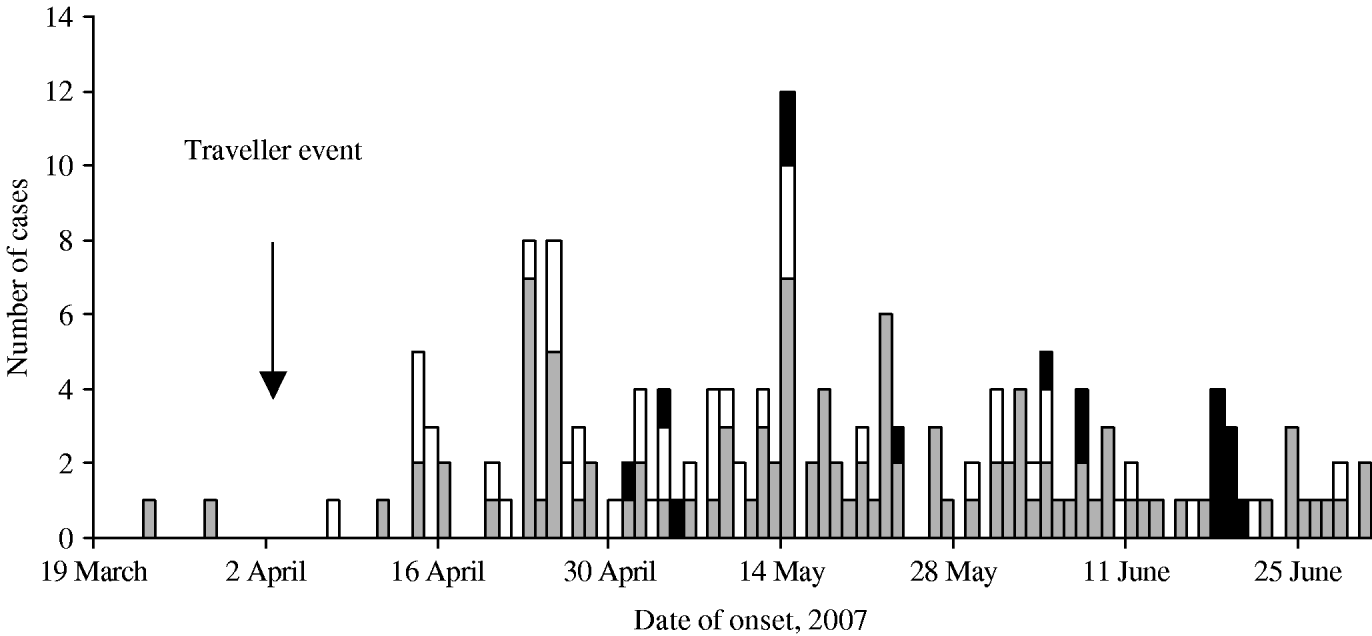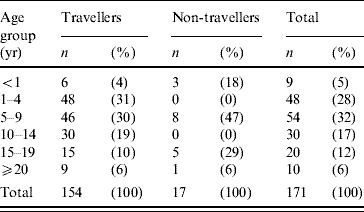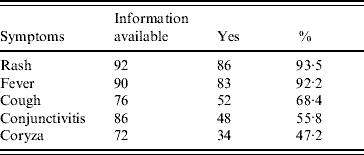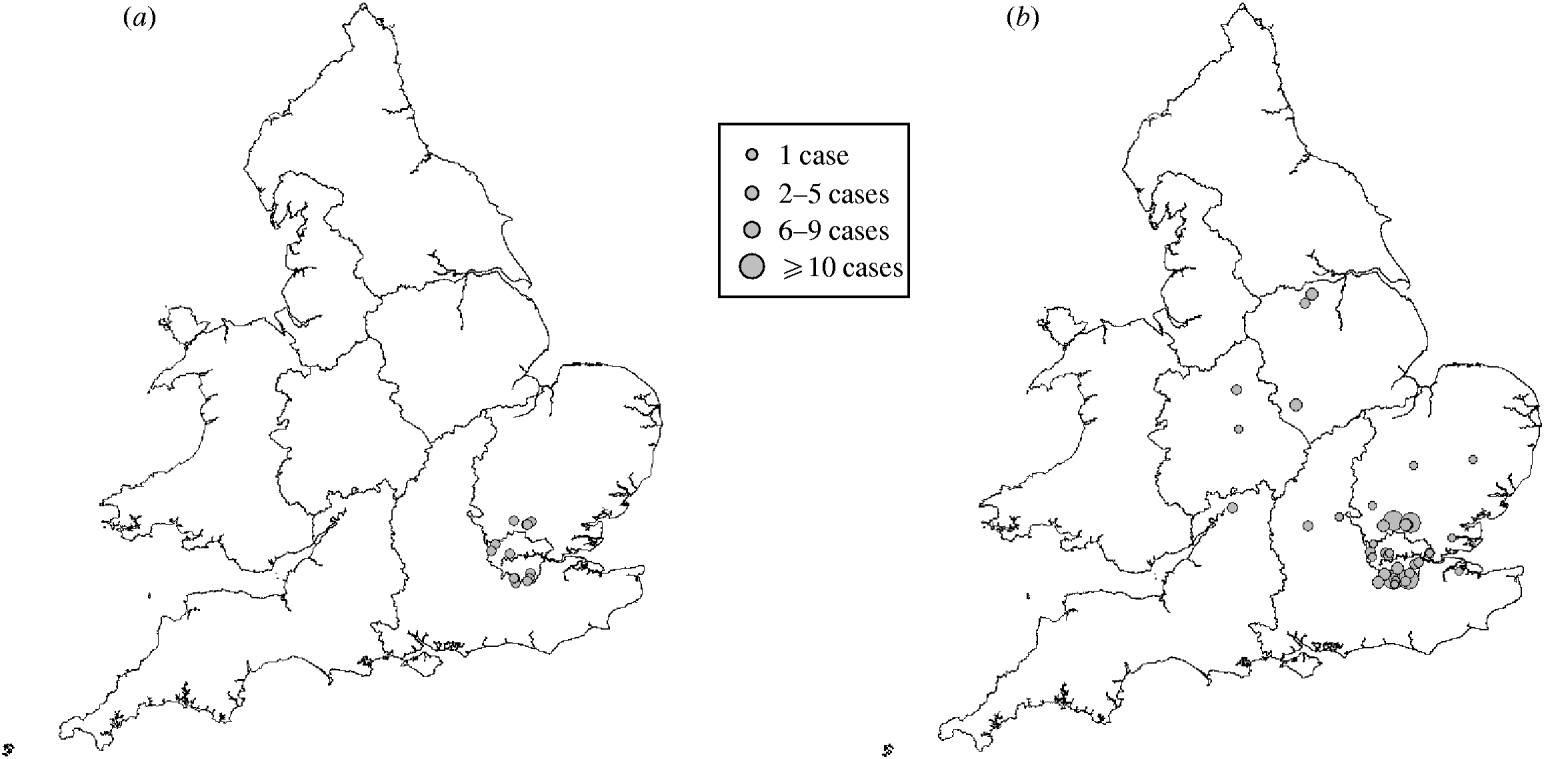INTRODUCTION
On 3 April 2007, the Health Protection Agency's (HPA) Virus Reference Department (VRD) of the Centre for Infections (CfI) confirmed two cases of measles in members of the Irish traveller community, a distinct ethnic minority group living in England. On the same day, an Irish traveller community funeral was conducted in South East London. By 18 May 2007, a total of 21 confirmed cases of measles linked to this event had been reported across three regions of England. Six confirmed cases in members of two Irish traveller families who had attended this funeral were also identified in Norway during April and May [Reference Løvoll1].
The UK childhood immunization schedule offers one dose of measles, mumps and rubella (MMR) vaccine between ages 13 and 15 months and a second dose between 3 and 5 years [2]. In England, vaccination coverage decreased after concerns about the safety of MMR were published in 1998 [Reference Wakefield3]. Although national MMR coverage has since increased, to 85% for the first dose at age 2 years by 2006–2007, it is still far below the 95% recommended level to eliminate the disease. MMR coverage is known to be even lower in London with 75% for the first dose at age 2 years in 2006–2007 [4]. In 2006, 740 laboratory-confirmed measles cases (mostly due to a B3 strain), were reported in England and Wales to HPA, with many clusters of cases linked to traveller communities [5].
Irish travellers have been in England since the eighteenth century and have been recognized in case law as a distinct ethnic minority group in Great Britain since 2000 (O'Leary vs. Allied Domecq; Gypsy Site Refurbishment Grant), protected under the Race Relations Act [6]. It is estimated that 15 000 live in Great Britain where most are born with English nationality. They are one of the most vulnerable, severely marginalized minority groups and are excluded from mainstream society in Britain.
Their health status is poor with life expectancy 10 years less than for the general population and mothers are 20 times more likely to experience the death of a child than the rest of the population. They report poorer health than comparable groups of residents from socially deprived inner city areas, other ethnic minorities and rural residents [Reference Van Cleemput7, 8]. Decreased access to health services less than the general population is suggested by low immunization rates and poor utilization of maternity services despite a high fertility rate [Reference Parry9, 10].
This paper reports the descriptive epidemiology of a measles outbreak in this marginalized community, and identifies spread to the general population. The implications of outbreaks concentrated in ‘hard-to-reach’ groups, such as travellers, are assessed in relation to local health protection actions, and more widely in relation to the goal of elimination of indigenous measles in Europe [11].
METHODS
For the purpose of this investigation, a probable case was defined as an individual with a clinical diagnosis of measles (fever and rash and one of conjunctivitis, cough or coryza); with an onset of illness date between 3 April and 30 June 2007, and who was either a member of the Irish traveller community living in England or had contact with a confirmed case associated with this outbreak in the previous 4 weeks. A confirmed case was a person in whom measles IgM had been detected in oral fluid or serum and/or measles virus RNA detected in either a blood, urine, throat or mouth swab and who was either a member of the Irish traveller community living in England or had contact with a confirmed case associated with this outbreak in the previous 4 weeks.
Measles is a statutory notifiable disease in all countries in the UK. Confirmatory testing was primarily performed by the VRD, CfI, as part of routine enhanced surveillance of measles in the UK, whereby all notified cases of measles are offered laboratory confirmation through oral fluid testing and any confirmed cases are followed up for epidemiological information including demographic details, date of illness onset, symptoms, general practitioners (GP) post code, hospitalization, membership of the traveller community, postcode of residence (including traveller campsite), known contact with measles cases, foreign travel in the previous 4 weeks, and vaccination status. Measles genotyping of measles RNA-positive samples was also undertaken as a part of the routine measles surveillance, and performed according to WHO guidelines.
To investigate this outbreak in Irish travellers, Health Protection Units (HPUs) throughout England were promptly alerted and asked to provide additional follow-up information on confirmed and probable cases by telephone interviews with GPs. They were also asked to report whether MMR vaccination had been offered on traveller sites either by fixed or mobile clinics, whether primary-care trusts (PCTs) had dedicated health visitors for travellers in their area, and if culturally sensitive health education and promotion materials regarding MMR and vaccination for travellers were being used.
RESULTS
Between 23 March and 30 June 2007, a total of 173 measles cases (124 confirmed and 79 probable) were identified associated with the Irish traveller community.
There were 156 cases (90%) that were members of the Irish traveller community and 17 (10%) in the general population who reported contact with a confirmed outbreak case, including two confirmed cases in siblings aged 6 and 4 years from a traveller site in Essex with illness onset of 23 and 28 March 2007 who had also attended the traveller funeral in South East London on 3 April. These cases were thought to be the index cases in this outbreak.
The epidemic curve by dates of illness onset showed repeated peaks between 14 April (11–13 days after the traveller funeral) and 1 June 2007, indicative of active transmission within the traveller community until the beginning of June 2007. From June 2007 the spread was no longer confined to the traveller community (Fig. 1).

Fig. 1. Probable and confirmed cases of measles in travellers and non-travellers by date of onset, England, 23 March to 30 June 2007 (n=168). (Five dates of onset were missing.) ![]() , Confirmed traveller case; □, probable traveller case; ▪, confirmed non-traveller case.
, Confirmed traveller case; □, probable traveller case; ▪, confirmed non-traveller case.
The median age of cases was 7·5 years (range 2 months to 32 years). In travellers, 31% of cases were pre-school age (1–4 years) and 49% were school age (5–14 years). Of the 17 cases in the general community, eight were of primary-school age (5–9 years) and six were adults (>14 years) (Table 1). None of the 94 confirmed cases (78 travellers, 16 non-travellers) eligible for vaccination (aged >1 year) and for whom reliable information was available (94/115, 82%) were vaccinated against measles at the time of exposure.
Table 1. Age distribution of cases in travellers and non-travellers, England, March–June 2007 (n=171Footnote *)

* Two dates of birth were missing.
More than 90% of confirmed cases reported rash and fever and around two thirds reported conjunctivitis, cough or coryza (Table 2). Thirteen cases were admitted to hospital: two had pneumonia but no other serious complications were reported.
Table 2. Symptoms reported by confirmed cases of measles in travellers and non-travellers, England, March–June 2007 (n=124)

Cases were identified in seven of the nine regions in England with the majority reported from the East of England (39%), London (31%), and South East England (20%) regions. Cases from other regions occurred after the end of April 2007, consistent with spread via the traveller community to other parts of the country (Fig. 2) and to Norway (where the first case occurred on 27 April 2007).

Fig. 2. Confirmed and probable cases of measles in travellers and non-travellers by region of residence in England, with illness onset (a) from 23 March to 30 April, and (b) from 1 May to 30 June 2007.
A total of 134 Irish traveller community cases lived on 17 different caravan sites across seven regions of England, and a further 22 travellers cases (14%) lived in conventional housing. Sixteen of the 17 general community cases lived in the East of England and London regions; 12 attended schools with traveller children; three children and two adults lived near traveller sites.
A total of 124 cases were confirmed by detection of measles IgM in oral fluid (91 cases) or in serum (13 cases) and/or by RNA detection in blood, urine or throat swab. All the 17 general community cases reported contact with a confirmed outbreak-associated case and were also laboratory confirmed. All the samples that were sequenced (74 cases) had the same identical strain of a measles genotype D4 virus that was identified in the original index cases (MVs/Enfield.GBR/14.07/[D4]-EF600554).
Public health interventions
Traveller organizations and societies were contacted to help raise awareness of the importance of MMR vaccination. Media interviews were performed on ‘rokker’ radio, a specific radio programme for the travelling community. GPs were contacted to aid prompt diagnosis and reporting of suspected cases as well as opportunistic vaccination of contacts and any unvaccinated children. Local authorities contacted schools with pupils from traveller communities through the traveller education teams to alert them to the outbreak. Awareness in the wider public health community was raised through publication of the outbreak investigation preliminary findings in the UK weekly Health Protection Report (HPR) and in the weekly Eurosurveillance [12, Reference Cohuet13].
Two of the 31 PCTs in London and four of those outside London assisted by HPUs, offered MMR vaccination on traveller sites using mobile clinics; no data was available on the total numbers of traveller children vaccinated on these traveller sites during this outbreak. Dedicated traveller community health visitors were working in the PCTs hosting the largest traveller communities in London and East of England. The Irish traveller movement and their representatives at local level were involved in designing health interventions in four PCTs, three in London and one in East of England. Culturally sensitive health education and promotion materials regarding MMR and vaccination for the traveller community were reported as being used in one London PCT. This London PCT was involved in the Pacesetters programme, a partnership between local communities who experience health inequalities, the National Health System (NHS) and the Department of Health (DoH) in six strategic health authorities across the country and looking at traveller health and inclusion issues [14].
DISCUSSION
This investigation of measles in the Irish traveller community identified 156 cases in travellers and 17 cases in general community contacts of traveller cases occurring over a 3-month period across 17 different travellers sites in most regions of England. International spread to Norway was also observed [Reference Løvoll1, Reference Løvoll15]. None of the cases were vaccinated, consistent with the low level of vaccination uptake in this community [Reference Parry9].
The D4 strain identified in this outbreak was novel, and had not been identified in any other country prior to its recognition in one of the first cases identified in March 2007. The source of the infection in the index case was never identified. We found limited direct evidence of spread from the traveller community to the general population in this outbreak investigation. The enhanced surveillance was time- and resource-consuming and implemented only for the purpose of this investigation. Most of the cases in the traveller community occurred from March 2007 to mid-June 2007. From mid-June, the spread was no longer confined to travellers and transmission was ongoing within the general population where epidemiological links between cases in this funeral outbreak were increasingly difficult to document. These are the reasons why we ended the investigation and the enhanced surveillance on 30 June 2007. However, routine national surveillance shows that the strain in this outbreak has continued to circulate widely in England and Wales [16]. From May 2007, an extended outbreak involving this D4 measles strain was reported in the orthodox Jewish community in London, with international spread to Belgium and Israel [Reference Ashmore17–Reference Lernout19], and in late 2007 and early 2008, the strain was also implicated in several major outbreaks in Europe involving the general population [Reference Filia20, Reference Nieto-Vera21].
Travellers' poor health status is closely linked to their social, education and housing disadvantage. A significant contribution to travellers' health inequities and social exclusion in England has been a persistent shortage of authorized transit and permanent sites [Reference Clark and Greenfields22, Reference Thane23]. Site shortages have meant either continual forced movement or pressure to settle leading to many now living in housing as illustrated by our study where 14% of the cases in Irish travellers lived in traditional houses. Currently, between a fifth and a quarter of traveller community caravans (3000–4000) in England still have no authorized place to stop at any time. Many Irish travellers in England live in caravans on unauthorized encampments (roadside) or on local authority sites. Other factors comprise the long-term failure of public services, including health services, to reach itinerant people; the travellers' tendency to avoid contact with or trust bureaucracy, together with a lack of flexibility in service provision and history of prejudice and discrimination from the settled community, the media and previously those who designed and delivered public services [Reference Van Cleemput24]. An Irish Traveller Movement (ITM) was established in November 1999 following the recognition of a gap in service provision and the marginalization of the Irish traveller community living in Britain. It seeks to raise the profile of Irish travellers and increase their say in decision-making processes and forums [25].
Between 2006 and 2007, other European countries including Italy, Spain, Greece and Serbia reported clusters of measles linked with unvaccinated travellers that involved a total of 534 measles cases (242 laboratory confirmed) [Reference Filia26–Reference Zeguliev29].
This measles outbreak in the Irish traveller ethnic group highlighted the epidemiological patterns associated with nearing elimination of a disease: outbreaks concentrated in ‘hard-to-reach’ groups such as travellers, sporadic cases or clusters of cases in the general community, and cases associated with importation from endemic countries such as was observed during this outbreak where cases were exported from England to Norway.
Based on the results of our investigation in 2007, we recommended organizing an information campaign for the general population in England to emphasize the importance of a completed MMR vaccination of school-age children and catch-up vaccination campaigns for schoolchildren in close collaboration with traveller education liaison teams. A national MMR catch-up campaign was launched in England by the DoH in August 2008 [30].
Based on the results of our investigation and on previous experience of the HPUs in England, we suggest a parallel approach to offer targeted actions to reach this marginalized population, whilst improving their integration within national health services. Public health nurse posts dedicated to travellers and vaccination campaign on traveller sites using fixed or mobile clinics should be developed, particularly by the PCTs with the larger traveller communities in England. Health interventions should be developed in collaboration with the local representatives of the ITM and the influential members at the travellers' sites. The development of culturally sensitive materials in an appropriate format to promote vaccine uptake including MMR should be encouraged and widespread across England. Targeted interventions for gypsies and travellers within Europe have shown promising improvements in vaccine uptake where health providers have built up relationships with these communities and offered vaccination on site [Reference Baglio31]. The evaluation of these targeted public health measures should be also a priority in England, with PCTs collecting routine data on the number of vaccinations given on traveller sites. The health sector needs to develop innovative ways of including travellers within its health programme planning, recognizing barriers and assessing particular needs of itinerant groups. GPs and hospital trust staff should be educated about travellers and their distinct culture, specific needs and living conditions. An efficient and workable system for keeping traveller patient records tracking and transferring them when families move should be implemented.
CONCLUSION
Low vaccination coverage and frequent movement of traveller communities present a particular challenge for measles elimination in Europe. This outbreak emphasizes the urgent need to ensure Irish travellers are engaged with primary health-care services so that high vaccine coverage can be achieved, and that well targeted susceptible public health measures to protect against measles are in place for all other low-vaccine coverage groups in England and in other European countries.
ACKNOWLEDGEMENTS
The authors acknowledge the HPA's regional epidemiologist Dr Isabel Oliver, Mrs Ruth Roach at East of England Regional Unit and the Health Protection Units (HPUs) who submitted outbreak data: Mrs Sarah Petrie, Dr Gayatri Manikkavasagan Dr Vicky Miaris, Dr Steggall, Mrs Katie Fleet, Dr Mathibalasingham Chandrakumar, Mr Kevin Carroll, Mr Sim Badjwa; Dr Nachi Arunachalam, Mrs Janet Howard in South East, South West and North West London HPU, Essex and Hertfordshire HPU, Kent and Surrey-Sussex HPU, East Midlands South HPU, South Yorkshire HPU and Gloucester HPU. We are also very grateful to Dr Oliver Morgan, Locum Epidemiologist for HPA London Region, for his major contribution at the beginning of this investigation.
DECLARATION OF INTEREST
None.








